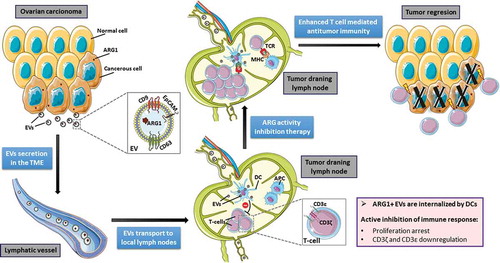Figures & data
Figure 1. Suppression of T-cell mediated antitumor immune response by extracellular vesicles (EVs) containing arginase-1 (ARG1). Ovarian carcinoma (OvCa) cells produce ARG1 and release this enzyme in secreted EVs to the local tumor microenvironment (TME). EVs are being transported by lymphatic vessels to local lymph nodes. Tumor-derived ARG1-containing EVs are internalized by dendritic cells (DCs) that acquire inhibitory properties and suppress T-cell proliferation. Blocking of ARG activity restores the proliferative potential of T-cells. Activated T-cells can differentiate into effector cells exerting antitumor activity. Figure was created with images adapted from Servier Medical Art licensed under a Creative Commons Attribution 3.0 Unported License.

